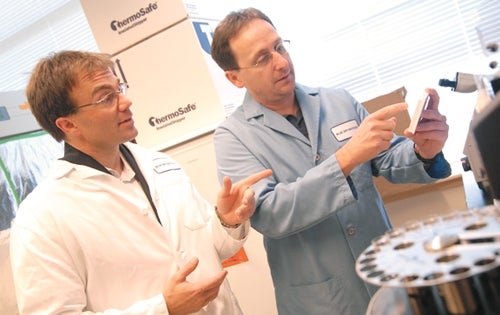With any job, using the wrong tools very often leads to failure.
Nowhere is this more relevant than in early drug discovery.
Over the last 20 to 30 years, pharmaceutical companies have experienced significant growth and accelerated exposure due to aggressive marketing campaigns.
Still, the number of new drug applications has not matched the incredible investment the industry has made in drug discovery over the decades, according to Norman Garceau, president of Blue Sky Biotech in Worcester. Many simply fail in the initial explorative phase.
But Blue Sky, having acquired a progressive new technology called TDA 2.0, is poised to spark an evolution in the industry — and potentially reinvent the early drug discovery process of the 21st century.
The technology provides new “biological picks and shovels for drug miners,” explained Blue Sky CEO and founder Paul Wengender, also calling it a “game changer.”
The Science
In early drug discovery, scientists initially identify a genetic or cellular pathway that plays a part in a certain disease. Then, as they seek to develop a new drug, they work to identify and isolate “targets” – proteins in that pathway — that are modulated, activated or inhibited by a drug molecule.
As Garceau explained, 60 percent of such targets are membrane-associated proteins (or proteins attached to a cell membrane).
This is where TDA 2.0 — standing for “template-directed assembly” — quite literally fits in.
The technology simulates a membrane, mimicking a protein. This presents targets in a more biologically-relevant way, putting proteins “in the proper context” and ultimately allowing for more accurate results during the drug discovery process, according to Wengender.
Without a system like TDA, scientists have been forced to simplify, using a version of a protein without a membrane in a non-native environment.
This is because membrane-associated proteins are often difficult and hydrophobic (repelled by water), so it’s easier for scientists to simply ignore the membrane altogether, explained Scott Gridley, director of Blue Sky’s BioProducts division.
But these simplified alternatives often don’t behave the same way as the proteins would, so the “context is not physiologically relevant,” Garceau noted. Beyond staging a proper environment, a membrane also provides a fluid surface that dictates polarity, topology and spatial relationships, what Gridley called “critical properties” for a membrane protein’s function.
Going To Market
Sold in off-the-shelf kits or customized assemblies, the technology is intended for use in the first two years of a drug discovery process — a process which, in some cases, can take up to 16 years and cost more than a billion dollars.
“Our primary directive is to accelerate that process and improve the quality of the data in that process,” said Wengender.
First developed at UMass Amherst under Robert Weis, Blue Sky acquired the worldwide exclusivity to develop and commercialize TDA 2.0 earlier this year. The company, which launched in April 2003 and operates with two arms, has grown its revenues more than 20 percent per year since its inception.
Given this expansion, Blue Sky is expected to upgrade from its space in Worcester’s Gateway Park to a larger spot at the facility, according to Kevin O’Sullivan, president and CEO of Massachusetts Biomedical Initiatives. Also, the company’s BioProducts division, which now employs six, is expected to add 20 to 30 new employees in the next three to five years.
It’s an aggressive strategy and growth pattern that O’Sullivan attributed not just to the innovative and intuitive TDA 2.0, but to Wengender’s “drive, tenacity and vision” and astute ability to recruit key scientists.
“Ultimately it comes down to science,” O’Sullivan said. “But there are a lot of good scientists who have ideas but can’t get them out into the market. You have to have the money, the vision, the team. If it was easy, everybody would be doing it. [Wengender is] one of the premier innovators and visionaries in the field.”
And that vision, if realized, would reap big profits for the pharmaceutical industry.
Ultimately, though, the implications go far beyond dollars. The innovation would allow for the discovery of more new drugs to battle diseases. For instance, Blue Sky is currently working with Pfizer to identify a target for diabetes.
But, as Wengender stressed, “It’s still a young venture.”
To cultivate its potential, then, the technology needs research-based pharmaceutical companies to take a chance on it — early adopters that are willing to break away from the traditional approach.
Once that happens, Wengender is confident it will take off. “They will convert the rest of the industry, and it can become the industry standard.”
“We’re standing at a frontier,” Wengender said. “The landscape is really fertile from a scientific perspective.”
Taryn Plumb is a freelance writer based in Worcester.

